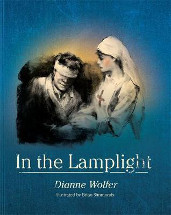In the lamplight by Dianne Wolfer

Ill. by Brian Simmonds. Fremantle Press, 2018. ISBN 9781925591224
(Age: 10+) Highly recommended. Themes: World War One, Hospitals,
Nursing, Spanish influenza, Armistice. With copious charcoal
illustrations, archival material and a story told through diary
entries alternating with text, this highly readable tale of two
people surviving the rigours of World War One is intense, intimate
and involving.
Following the success of her two books, the award-winning Lighthouse
Girl (2013) and Light Horse Boy (2009), Wolfer has
followed the journey of Light Horse Boy, Jim as he
languishes in a rehabilitation hospital in Harefield village in what
is now Greater London, unsure of whether he will see again.
Here he is nursed by Rose a local girl from the nearby village, and
it is her diary we read as she falls in love with this Australian
soldier, one of the 50,000 Australians and New Zealanders nursed at
this hospital. Each time a coffin makes its way to the cemetery from
the hospital, it is draped with a Union Jack and that flag made its
way to Adelaide High School, where it has been recently restored by
Artlab and will be on display for the celebrations marking the
centenary of the end of World War One.
Through Rose's diary entries we hear of her life in Harefield before
the war, which contrasts with life during war as privation set in,
and the thousands of wounded come back from Europe. She decides to
become a nurse to help care for these men, despite her family's
anxiety. A girl in the village sends white feathers to those men who
have not joined up, some mothers receive telegrams about their sons'
deaths, but the village opens its heart to these wounded soldiers.
The archival material gives a wonderful impression of life at
Harefield Hospital, with photos of the recovering soldiers, their
dormitories, the funerals, celebrations, nursing staff and mascots.
I found this an engrossing read, one which gives a sound background
to the lives of those we rarely read about, the men in hospitals,
the staff who cared for them, those who remained home.
I can imagine many readers poring over the detail, and checking out
the story of the flag that draped the coffin, which can be found here.
The map, background information and even the acknowledgements make
for fascinating reading after the book has been read.
I thoroughly recommend this as a highly readable account of how war
affects lives far beyond the battlefield. In joining Jim in
Australia, Rose leaves her country and her family for ever, taking a
risk on a man who has never seen her. It's an amazing thought, but
one which parallels the changes taking place for women after World
War One. Teacher's
notes are available.
Fran Knight